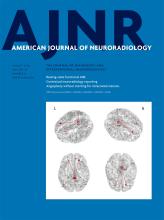Abstract
BACKGROUND AND PURPOSE: Recently published North American Imaging in Multiple Sclerosis guidelines call for derivation of a specific radiologic definition of MS WM lesions and mimics. The purpose of this study was to use SWI and magnetization-prepared FLAIR images for sensitive differentiation of MS from benign WM lesions using the morphologic characteristics of WM lesions.
MATERIALS AND METHODS: Seventeen patients with relapsing-remitting MS and 18 healthy control subjects were enrolled retrospectively. For each subject, FLAIR and multiecho gradient-echo images were acquired using 7T MR imaging. Optimized postprocessing was used to generate single-slice SWI of cerebral veins. SWI/FLAIR images were registered, and 3 trained readers performed lesion assessment. Morphology, location of lesions, and the time required for assessment were recorded. Analyses were performed on 3 different pools: 1) lesions of >3 mm, 2) nonconfluent lesions of >3 mm, and 3) nonconfluent lesions of >3 mm with no or a single central vein.
RESULTS: The SWI/FLAIR acquisition and processing protocol enabled effective assessment of central veins and hypointense rims in WM lesions. Assessment of nonconfluent lesions with ≥1 central vein enabled the most specific and sensitive differentiation of patients with MS from controls. A threshold of 67% perivenous WM lesions separated patients with MS from controls with a sensitivity of 94% and specificity of 100%. Lesion assessment took an average of 12 minutes 10 seconds and 4 minutes 33 seconds for patients with MS and control subjects, respectively.
CONCLUSIONS: Nonconfluent lesions of >3 mm with ≥1 central vein were the most sensitive and specific differentiators between patients with MS and control subjects.
ABBREVIATIONS:
- CVS
- central vein sign
- EDSS
- Expanded Disability Status Scale
- HC
- healthy control
- IEV-SWI
- inter-echo variance susceptibility-weighted imaging
- LL
- lesions of >3 mm
- MP-FLAIR
- magnetization-prepared FLAIR
- NC
- nonconfluent lesions of >3 mm
- %PVWML
- percentage of total perivenous white matter lesion count
- RRMS
- relapsing-remitting multiple sclerosis
- SV
- nonconfluent lesions of >3 mm with a single central vein
- WML
- white matter lesions
- © 2018 by American Journal of Neuroradiology
Indicates open access to non-subscribers at www.ajnr.org












